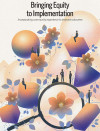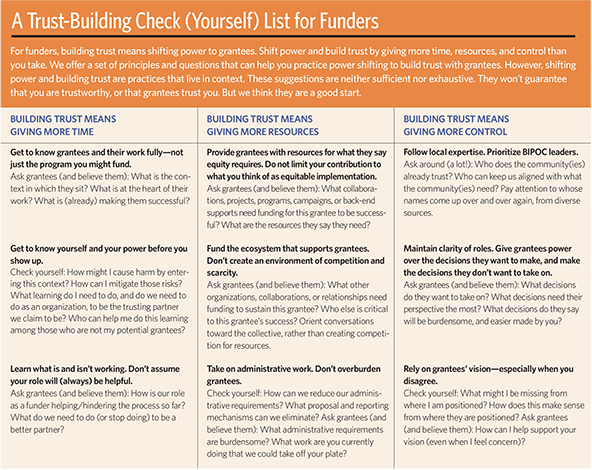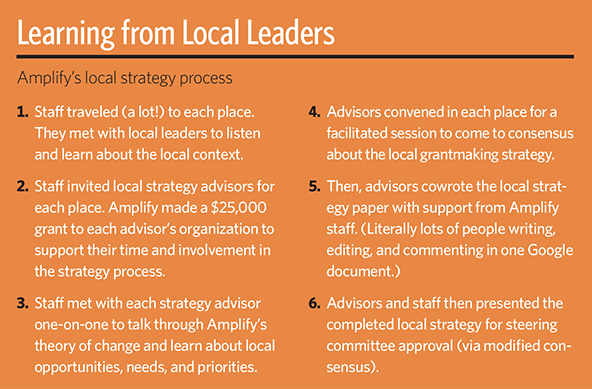 (Illustration by Maggie Chiang)
(Illustration by Maggie Chiang)
This is a story about a relationship between a legal advocacy organization (ArchCity Defenders) and a philanthropic funder (the Amplify Fund) that is grounded in mutual trust. We came together around a campaign to close a jail and to redirect its resources back into the hands of the community it’s harming. Our story is about small moments gone right against a backdrop of problematic relationships and power dynamics between funders and the organizations they purport to support. We’ve found that it is in the mundane, everyday moments where we most frequently have the capacity to choose: the violence of the status quo, or the transformative possibility of trying something new. We share our practices for funders and grantees pursuing equity in and through their implementation relationships.
Bringing Equity to Implementation

Implementation science—the study of the uptake, scale, and sustainability of social programs—has failed to advance strategies to address equity. This collection of articles reviews case studies and articulates lessons for incorporating the knowledge and leadership of marginalized communities into the policies and practices intended to serve them. Sponsored by the Anne E. Casey Foundation
-
Equity Is Fundamental to Implementation Science
-
Trust the People
-
Youth Leadership in Action
-
Community Takes the Wheel
-
Equity in Implementation Science Is Long Overdue
-
Listening to Black Parents
-
Faith-Based Organizations as Leaders of Implementation
-
Community-Defined Evidence as a Framework for Equitable Implementation
-
Community-Driven Health Solutions on Chicago’s South Side
-
Equitable Implementation at Work
Blake Strode: I am the executive director of ArchCity Defenders (ACD), based in St. Louis, Missouri. ACD engages in direct representation, civil litigation, media and public engagement, and close partnerships with organizers across the St. Louis region. We take a holistic approach, meaning that we provide a range of legal and nonlegal supports to our clients, and we engage in individual and systemic advocacy that is varied and multifaceted. We work with people seeking to rebuild their lives after being targeted and punished by a criminal legal system of police, courts, and jails in communities struggling to overcome decades of neglect, disinvestment, state violence, and exploitation. Our client relationships are the most important part of our work and are a model for the relationships we pursue with colleagues, partner organizations, funders, and the greater St. Louis community.
I come to this work as a proud native son of St. Louis, a queer Black man and a former athlete-turned-litigator-turned-executive director, an attorney by profession and an advocate by vocation. My life was forever changed by the 2014 uprising in Ferguson. Just a few days after Michael Brown Jr. was shot and killed by police, and left lying on the hot August pavement for the world to see, I was set to depart St. Louis for my final year of law school. Like so many others, I watched the uprising in my hometown with a bevy of emotions: fury at the all-too-familiar sight of white supremacy and racist violence; deep distrust of the institutions marshaling to justify and rationalize the injustice; and growing pride in the brave young people calling an entire nation to account. At that moment I knew, contrary to my earlier intentions, that I aspired to return to St. Louis and be a part of the fight for justice.
The uprising was about more than extrajudicial killing. St. Louisans rose up to protest the broader systems of policing and prisons that destroy countless lives, families, and communities, sometimes over infractions as trivial as an unbuckled seat belt, speeding, or a property-upkeep ticket. One of the most infamous sites in this devastating system of wealth-based criminalization is St. Louis’ “Medium Security Institution,” commonly known as the St. Louis Workhouse. For decades, the Workhouse has held St. Louisans in cages with black mold, routine violence, rodent and insect infestations, mice feces in food, snakes in showers, and terrible medical care, while costing taxpayers $16 million every year. While advocates and organizers, including ACD, have broadly exposed the extent of the devastation in recent years, St. Louisans have long known the Workhouse terrorizes people, most of whom have not even received their day in court. In 2017, ACD met with partners from Action St. Louis, the Bail Project, and Missourians Organizing for Reform and Empowerment (MORE). ACD was already in deep relationship with these partners, having previously worked to organize town halls in communities impacted by policing and mass incarceration to amplify and lend voice to those communities’ visions of re-envisioning public safety. Now, we were committing to combat the injustice and to put the public funds wasted on the Workhouse back in the people’s hands. The official Close the Workhouse Campaign (CTW) was finally born.
But good ideas need resources. We explored many sources of funding, but it was difficult to find philanthropic support. CTW’s goals and political frame directly challenge the kind of power and privilege held by philanthropy, and the campaign’s work was not so easy to communicate in palatable terms. Some funders responded that our initiative was insufficiently “measurable” or “practical.” Other funders demanded a single accountable party, not just for application and reporting purposes, but also to ensure that all funder expectations would be met. Some funders were willing to fund legal work but not organizing, or fund organizing but not wraparound support for members, or fund bailouts for “nonviolent offenders” but not legal advocacy. With their offers of funding, these outside actors were seeking to define not only what change was needed but also how change needed to happen. The need to jump through ever-changing hoops and contort ourselves to satisfy potential funders’ prescriptive desires was exhausting and would sap energy from the real work. We needed a different kind of funding relationship.
Amy Morris: I have the privilege of serving as director of the Amplify Fund at Neighborhood Funders Group. Amplify is a pooled grantmaking fund with twin goals: Black people, Indigenous people, and people of color (BIPOC) should have more power to influence decisions about the places where they live, and philanthropy should have a clear model for equitable development centered in racial justice. Amplify emerged to challenge the weakness inherent in many models of philanthropy, with foundations serving as tax havens and without accountability. By creating a pooled fund, Amplify is working to disrupt the traditional role of program officer as benevolent overseer, and move toward getting in relationship, and in line, with work already underway.
In 2017, when the initial funders launched Amplify, I was the only staff member. I showed up in places like St. Louis with a clear theory of change: bring resources to BIPOC leadership, respect their knowledge of local communities and needs, and support their work holistically—not through oversight, reporting, and requirements, but by putting decision-making power in their hands, taking tasks off their plates, and amplifying their work on a national stage. Through a months-long process, we would build relationships, learn about the organizational and movement infrastructure, gather a group of local strategy advisors (LSAs)—local leaders from movement and philanthropy—and work with them to cocreate a grantmaking strategy.
I also showed up in St. Louis as a white woman who had never set foot there before my first trip with Amplify in 2017. I had watched the Ferguson uprising in 2014-15 from my then-home in Brooklyn, New York. Outraged, I showed up for solidarity protests, but didn’t grasp how decades of planning and development decisions had made St. Louis one of the most segregated metro regions in the United States, ripe for this sort of uprising.
Those doing the work on the ground in St. Louis did not need, and would not tolerate, another well-meaning white savior. In listening to local leaders, I learned how national philanthropy reacted to the Ferguson uprising from a place of urgency—working in uncoordinated and unaccountable ways that exacerbated negative dynamics between leaders in the region and unknowingly deepened generational, political, and gender divisions between groups. In coming to St. Louis, I learned, once again, the critical challenge in relationship building while holding more power—as a white-led organization with resources—was demonstrating our trustworthiness to local leaders, not the other way around.
We met ArchCity Defenders through our LSAs, many of whom were ACD’s close allies. One of them was Kayla Reed, executive director of Action St. Louis, which is also a core partner of the CTW campaign. Our LSAs explained that ACD was an anchor in the region and in the movement ecosystem. However, it took time for us to really connect with ACD. While we built strong relationships with our LSAs early on, we stumbled in building our broader web of connections. Through a mix of ambition, new-project energy, and minimal staffing, we promised presence to ACD when we didn’t yet have the bandwidth to build additional relationships.

Fortunately, our relationships with LSAs gave us a second chance. We learned from early mistakes and staffed a St. Louis team member. Our relationship with ACD eventually blossomed after devoting more time and presence. We built trust together, through long and meandering conversations. We learned about ACD through their public-facing work like ACD’s and Action St. Louis’ podcast Under the Arch. ACD learned about us through the people they already trusted—LSAs who had come to know Amplify. We asked about ACD’s clients, and ACD asked about our values and priorities. We also observed how ACD and the LSAs were already building power together and learned our role was to support an ecosystem already alive and breathing.
And yet I hesitated when CTW told us that they needed flexible funding to support divestment from the Workhouse: “Equitable development is our focus, not closing a jail. Right?” My colleague Lorraine Ramirez of Funders for Justice, and Amplify’s senior program officer, Melody Baker, helped me check my assumptions: BIPOC communities building power to influence or decide what the city invests in is equitable development. Strategic Black leaders are telling us that CTW is a key opportunity. Instead of relying on my preexisting vision for equitable investment in St. Louis, I needed to listen, align, and act.
Ultimately, we provided CTW with flexible resources, and—because it is always our practice—minimal proposal and reporting requirements. Then we got out of the way. The CTW coalition used those funds to further cement a robust and nimble campaign that combined bailouts, legal advocacy, public education, and grassroots organizing of impacted people. After two years of official CTW organizing, the campaign reached an incredible milestone: On July 17, 2020, the St. Louis City’s Board of Aldermen voted unanimously to close the Workhouse, and to use a participatory budgeting process to reinvest its budget.
We’ve seen the power-shifting and power-building that is possible when funders get in line with movement. Through our experience in St. Louis, Amplify’s staff has come to see divest-invest campaigns as a pinnacle of equitable development. By trusting people closest to the problems, and adapting our strategies to their needs, we are winning what some people saw as an impossible fight. But the work is far from over.

Blake Strode: At ACD, we have learned that the only way to keep winning is by deepening and spreading our connections. Through our collaborative work together, Kayla Reed of Action St. Louis, Charli Cooksey of WEPOWER, and I had long talked about the importance of cultivating relationships with other young Black leaders in St. Louis. Kayla and Charli are also Black leaders of organizations fighting for racial justice, so we share a desire to expand the region’s movement ecosystem. The energy and courage of the Ferguson uprising made new things possible in St. Louis and across the country. But without infrastructure for collective strategy, local leaders struggled to coalesce and focus that energy in alignment with shared purposes. So, we set about designing a shared space to align our strategies and develop our leaders to respond to this challenge. What we have been building is now called leadBlack STL.
At first, we tried to convene ourselves. But our efforts sputtered due to ongoing demands on our time, limited resources, national actors’ unhelpful insertions (and withdrawals), moment-to-moment trauma, and gendered and generational dynamics. Yet we kept talking about the need. As Amplify listened and learned through the process of cocreating a Missouri grantmaking strategy with local leaders (LSAs), they reflected back our own desire for a leadership, learning, and strategy-building space. Amplify, along with Deaconess Foundation—a key funding and convening presence in the region—also shared their willingness to provide the resources we needed to get this off the ground.
It was important to all of us, including Amplify, that the process of forming such a space reflect our values: shifting decision-making power toward those most directly affected, and the burden of logistics and coordination toward those with resources. In practice that meant confronting our own conditioning within philanthropic culture. In our experience, funders typically require reports of expenditures, impact statements, or presentations. They typically require final decision-making power. Even funders leading with the language of equity tend to eventually vie for control or punish deviations from the routine of philanthropic relationships. These mundane surveillance patterns, assuming distrust and presuming grantees are the ones who need questioning, are often the difference between equitable implementation and philanthropy as usual.
Taking this approach led to questions like: Who should build the process? Who should write the RFP for a design consultant? Who should interview candidates? Who should select the candidates? Whose input do we need along the way? Once we have a design consultant, whose approval do they need? We struggled through these questions together. Amplify staff members Amy and Melody checked in regularly throughout the request for proposal and hiring process—continuously searching for the right role that would articulate our voice, respect our decision-making, and not add to our workload. With practice, we found a principle to guide us: It was our decision, without limitation, but also with support. We were free to ask for help that took work off our plate. Through consistent practice, one step at a time, we developed a different kind of funding relationship.
After a months-long design process, we are set to launch leadBlack STL in late 2021 as a base for young Black leaders in St. Louis to develop a shared political analysis informed by a lens of systems change and racial justice, and to build the power of Black leaders to create transformative, just, and equitable systems so that Black people can have better lives in the St. Louis region. We are currently seeking more financial support for this effort before launch, and we hope it will help us grow an even stronger relationship ecosystem.
Blake Strode & Amy Morris: At ACD, we are practicing building relationships in alignment with our vision for a liberatory future. At Amplify, we are still improving our ability to build trust, and believe doing so makes us better, more aligned, and our grantmaking strategy more equitable. Together we’ve learned that trust is built through a series of very small, but very radical, shifts in how we relate to each other over time. We know that trusting relationships are integral to the change we seek.
Support SSIR’s coverage of cross-sector solutions to global challenges.
Help us further the reach of innovative ideas. Donate today.
Read more stories by Blake Strode & Amy Morris.

